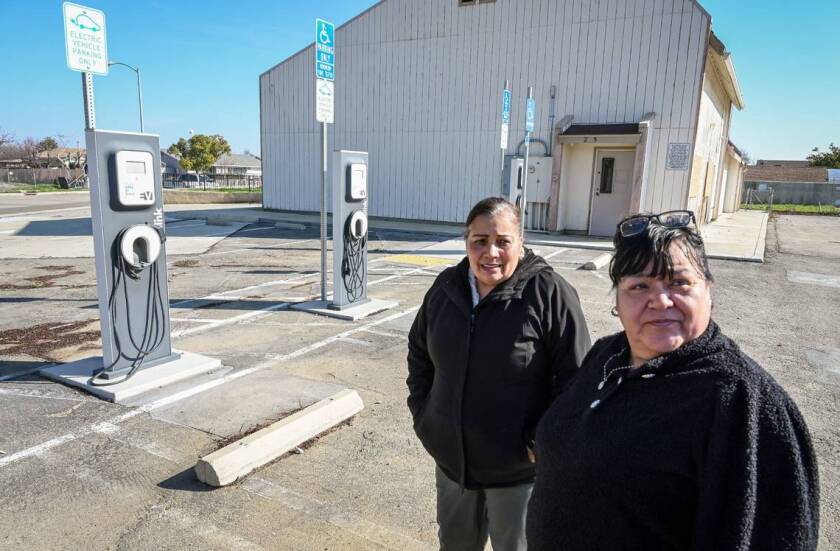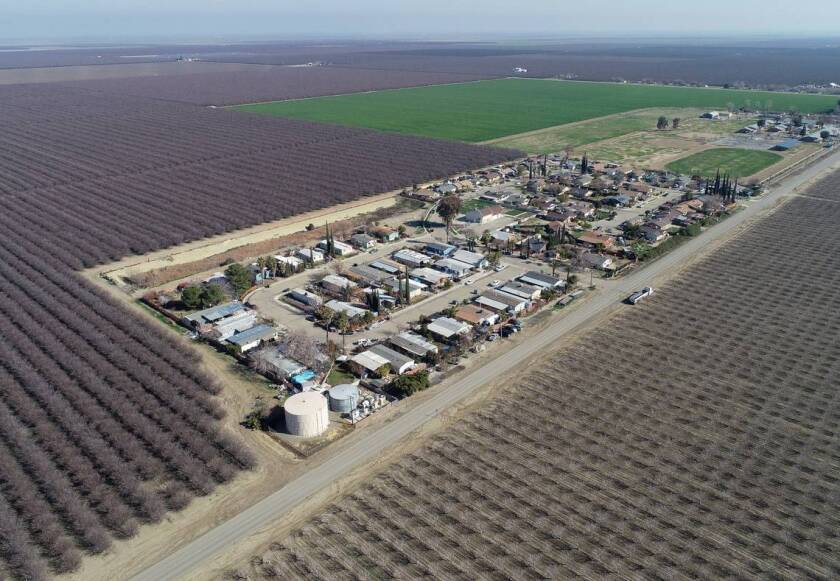Over five short months and with nearly $2 million, the state powered a fleet of Teslas and Chevy Bolts that lent residents of this isolated community a transportation lifeline. Then one day at the height of the COVID-19 pandemic, the cars vanished.
“Overnight, our means of transportation disappeared,” said Rosario Rodríguez, a resident of Cantua Creek. “We felt a lot of emotions all at once, because it left us defenseless. If we get sick or have a medical appointment, then what? What are we going to do?”
Nearly three years later, the electric cars are in Los Angeles and Rodríguez is back to relying on favors from friends to make the 30- minute commute to her nearest supermarket and hour-long drive to doctor’s appointments.
The vehicle chargers, once seen as an innovative solution to a woefully inadequate transportation system, are monuments to a bungled state program and the indignity endured by Rodríguez’s community when it briefly enjoyed, and then abruptly lost, a basic resource.
Lifting up disadvantaged populations is a relatively new and growing part of California’s spending to avert the worst consequences of climate change. Yet Cantua Creek has become a cautionary tale for shortsighted projects that can leave the state’s neediest further behind.

CRAIG KOHLRUSS/TNS
Van y Vienen, Come and Go
Rodríguez, 47, lives in Tres Piedras orThree Rocks, a community of a few dozen families whose members work in the fields several miles down the road fromCantua Creek.
The neighborhoods are 20 miles away from the nearest big box store and over 30 from the closest hospital. A majority of residents live below the poverty line, with a median household income of $36,000. Both communities are 100 percent Latino, according to census data.
Public transit is sparse and, like many of her neighbors, Rodríguez doesn’t drive. But she often needs to travel to Fresno and Clovis for doctor visits. Typically she relies on lifts, planned a week in advance from friends who drive cars, or rides from others who charge as much as $60.
“If we want to get groceries or other things, or do something else, we can’t go,” she said. “There are people in the community who help us, who do us favors, but they don’t always have the time to drive everyone.”
A nearly $2 million program called the Valley ZEV Mobility Project promised to solve that problem with zero-emission car sharing in low-income communities across Fresno, Merced and Kern counties.
In a November 2019 launch, the San Joaquin Valley Air District officials heralded the arrival of four shared vehicles in Cantua Creek — two Tesla Model X’s and two Chevy Bolts.
Through the program, community members could volunteer to drive through an app set up by a private ridesharing company called Green Commuter. Rides cost passengers between $5 and $10, depending on distance.
At a total $1.9 million, the project was funded with $749,800 from California Air Resources Board (CARB) using revenue from the state’s cap-and-trade program, which sells carbon pollution permits to industrial greenhouse gas emitters. Green Commuter contributed $1.1 million, and the Valley Air District chipped in the rest.
Throughout the region, 9 electric vehicles and 30 charging stations were placed in Cantua Creek, Delhi and Atwater. The goal was to improve transportation access and electric vehicle use in rural areas, plus offer a way for those driving community members to make some extra income.
And it actually worked.
Rodríguez and several neighbors said they got to their jobs, classes and doctors appointments smoothly. They relied less on family members who would have to skip a day of work and precious income. Beyond commuter trips, the cars were available to rent for longer drives at around $20 a day.
“The drivers would be ready the next day, take you to the doctor and wait for you until your appointment ended to bring you back,” said Celia Nazarit de Franco, a senior Cantua Creek resident. “You could take care of your business and not worry about the return trip home. It was comfortable.”
Leadership Counsel for Justice and Accountability, a social justice organization that applied for the grant, said the car sharing venture was a success for the time it ran. The organization called it‘Van y Vienen,’a play on words meaning ‘come and go’ in Spanish.
“If you put decision-making and design of transportation services in the hands of communities to formalize practices they already have, there’s buy-in and people use it,” said Veronica Garibay, the organization’s director. “Then it stopped because of COVID-19, and it just never came back.”
CARB designed the program as a pilot, intended to run until early 2022. Agency staff said they planned to secure more local, state or even federal funding after demonstrating its success.
But Van y Vienen ended in April 2020, just four months after it began, as a precaution against the spread of COVID-19. To the disappointment of people in Cantua Creek, Green Commuter absorbed the vehicles into its Los Angeles fleet per terms of the grant.
Nearly three years later, none of the players involved take full responsibility for the project’s demise. CARB said the Air District couldn’t supplement state funds to sustain it, and the Air District points to Green Commuter’s business model as the core problem.
“It was so sad when the cars were taken,” said Julia Mendoza, a Cantua Creek resident who often volunteered as an EV driver. Her house is down the street from the empty EV charging stations, which sit next to a now derelict former fire station turned preschool.
Despite the ridesharing program’s brief success, no one is responsible for maintaining the charging infrastructure. Mendoza now uses her own van to take neighbors to important healthcare visits, but the time and gas money add up.
“Elderly community members came to my house asking for rides,” Mendoza said. “Sometimes I’d wake up at 5 a.m. to take [them] to their eye surgeries so they could see. This last year I drove two women who had no means of transportation, neither their parents or their partners drive, and they were pregnant.”

CRAIG KOHLRUSS/TNS
Lessons Learned
CARB, the agency tasked with setting the state’s ambitious climate agenda, has seenits budget soar in recent years, with money for clean transportation nearly tripling from hundreds of millions in 2018 to $2.61 billion this year.
The agency said 70 percent of that money is for underserved communities and those disproportionately burdened by environmental pollution, calling it “the state’s largest investment in equity.” In this undertaking, Cantua Creek is a sign of growing pains.
Sam Gregor, who manages mobility programs at CARB, said the ZEV Mobility Project taught the agency a major lesson. State grants for people with few alternatives need to come with long term plans, he said, because even policy experiments with the best intentions have human consequences.
“I’ve talked to those folks. I’ve heard stories about trips they made that they couldn’t have made, and I feel terrible that these projects have ended,” Gregor said. “What I can say is if we get more money allocated we’ll do our best to try and relaunch services but it’s going to take the support of many different teams.”
Similar EV ridesharing programs continue to operate in low-resourced communities around the state, from Los Angeles to the Bay Area and Sacramento. All of them, however, are threatened by proposed budget cuts.
The Sacramentoproject, which deployed 18 EVs at nine low-income and senior housing sites, may also end before its scheduled 2025 shutdown. CARB staff said the Sac Metro Air District is running out of funds after pandemic needs sucked up much of its total $5.8 million allocation.
Rey León, mayor of Huron, has sustained an electric vehicle rideshare program in the San Joaquin Valley calledGreen Raiteros for four years now. He said Cantua Creek would have been far better served by a grassroots non-profit than a private company based in Los Angeles.
“Green Raiteros was something born from us and for us, not a parachuting program that will dissolve when there’s no more money,” León said. “I’ve seen my mother’s struggle, my father was a bracero farm worker for 57 years. It’s unfortunate that they set up this program the way they did, because it’s a terrible way of serving the people.”
Cantua Creek also illustrated shortcomings in California’s traditional model for infrastructure development, said Alvaro Sanchez, vice president of policy at Greenlining Institute, an Oakland policy research and advocacy organization. Typically the state provides capital investment up front and local jurisdictions are left to figure out ongoing operations.
“The kinds of innovation that many communities need don’t fit nicely into that paradigm,” Sanchez said, because of limited resources on the local level. “So the question becomes ‘How do you structure these programs so that they have a viable financial plan for sustainability?’”
This program isn’t a complete failure even if it ended with a series of mistakes, said Ethan Elkind, climate program director at the UC Berkeley Center for Law, Energy & the Environment. The cars may be elsewhere and the chargers sit unused, but at least they exist.
“That’ll make it easier to reactivate [the chargers] as we move to all electric vehicles going forward,” Elkind said, also pointing to lessons learned by the agency as California hopes to model a smooth transition away from fossil fuels to clean energy.
But Rosario Rodríguez and her neighbors want solutions now. They have plenty of ideas — small buses that shuttle to and from Mendota, Kerman, and Fresno for one. It’s unclear to her whether anyone is listening.
“People from Sacramento already came to our town and we spoke with them,” Rodríguez said. “I don’t know what they do or how much help they can provide, but they leave. I don’t know if they forget about us or what, because we are not seeing any results.”
The Fresno County Rural Transit Agency has been growing a micro transit program for a decade that could better serve the county’s 39 unincorporated communities. But its general manager Moses Stites didn’t offer a timeline for expanding services to Cantua Creek.
“Like everyone else, we pay taxes,” Rodriguez said, indignant. “We have the same rights... After all that money was invested in transportation, why did they take it away?”
©2023 The Sacramento Bee. Distributed by Tribune Content Agency, LLC.
Related Articles












